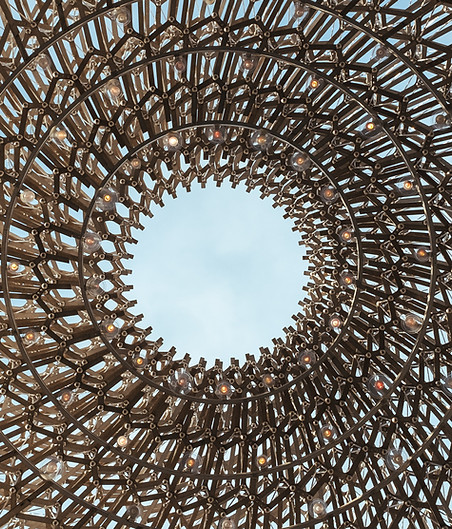Illuminate Your Space: The Essential Role of Lighting Design in Architectural Aesthetics and Functionality
- Eng. Evans Nusu

- Feb 6
- 5 min read
Lighting serves as a powerful tool in architectural design, shaping moods and enhancing functionality. Thoughtful integration of lighting not only creates dynamic environments but also highlights architectural features that evoke emotion and improve usability. This post explores the significant impact of lighting design on aesthetics and functionality in architectural spaces.
The Basics of Lighting Design
Lighting design encompasses more than just light. It combines art and science to understand light as a material that shapes environments. Key principles include the use of natural light, artificial light, layering effects, and shadow manipulation.
Natural light plays a vital role in design by creating a seamless connection between indoor and outdoor spaces. For example, large windows can flood a room with sunlight during the day, setting a warm and inviting atmosphere. On the other hand, effective artificial lighting allows spaces to remain functional after dark.
A well-thought-out lighting design features three main types of lighting:
Ambient lighting: Provides overall illumination for the entire area.
Task lighting: Focuses on specific activities like reading or cooking.
Accent lighting: Highlights particular features, adding visual interest.

The Emotional Impact of Lighting
Lighting significantly influences human emotions. Research suggests that well-designed lighting can enhance feelings of comfort, safety, and relaxation. This is particularly important in settings such as homes or hospitality spaces.
Warm color temperatures—typically between 2700K and 3000K—evoke comfort. For instance, living rooms and bedrooms equipped with warm lighting create a cozy retreat after a long day. In contrast, cooler temperatures (around 4000K) can energize areas like kitchens and offices, promoting productivity.
Understanding how light affects emotions enables designers to tailor environments that foster specific feelings. For example, a coffee shop might use soft, warm light to create a relaxed vibe, encouraging patrons to linger and enjoy their experience.
Highlighting Architectural Features
Effective lighting design draws attention to unique architectural features, transforming them into focal points. Whether illuminating textured walls, ornate ceilings, or striking structural elements, lighting can significantly enhance these characteristics.
For example, using uplighting on a textured wall can produce eye-catching shadows, emphasizing depth and detail. Additionally, strategically placed spotlights can draw attention to artwork or sculptures, making them stand out in a gallery or living room.
Lighting can also help delineate spaces within larger areas. For instance, using a combination of different lighting styles can guide visitors through an open-plan office, enhancing workflow and improving navigability.

The Role of Sustainability
With growing environmental awareness, sustainable lighting design has become increasingly important. Today’s designers must create spaces that are visually appealing and environmentally friendly.
Maximizing natural light can significantly decrease energy use. By incorporating design elements like strategically placed windows or skylights, buildings can capitalize on sunlight, reducing reliance on electric lighting during the day.
Moreover, LED lighting has transformed artificial lighting. LED bulbs use 75% less energy and last up to 25 times longer than traditional incandescent bulbs. This transition not only positively impacts the environment but also lowers energy costs for buildings over time.
Functional Considerations
Balancing aesthetics with functionality is essential in architectural design. Insufficient lighting can lead to dark spaces, making navigation and use challenging.
Consider kitchens, where proper task lighting is crucial for meal preparation. Placing pendant lights over countertops or installing under-cabinet lighting can effectively illuminate cooking areas. Similarly, office spaces require adequate lighting to minimize eye strain for employees working at desks for extended periods.
Designers must understand the needs of different spaces by assessing user behavior and daily usage patterns. For example, ensuring that conference rooms utilize both ambient and task lighting creates an adaptable environment for meetings.
Innovative Lighting Techniques
Advancements in technology have changed the landscape of lighting design. Innovations like smart home systems and advanced LED controls allow for remarkable creativity and flexibility.
Smart lighting systems enable users to adjust brightness and color temperature easily. This versatility allows settings to shift from bright and stimulating during work hours to soft and soothing in the evening.
Dynamic lighting can mimic the natural cycles of daylight, influencing mood and productivity. For instance, offices designed with circadian lighting adjust color temperature throughout the day, keeping workers engaged and energized.
The Importance of Coordinating with Other Design Elements
Lighting should complement other design elements, including color schemes, furniture, and decor. A cohesive design enhances an atmosphere and makes a space feel more inviting.
For example, warm-toned lighting can enhance earthy colors, creating a connection to nature, while cooler-toned light adds a crisp feel to minimalist designs. Additionally, light fixtures themselves can be key design statements. A sleek, modern pendant can elevate a contemporary dining area, while a vintage chandelier can add charm to a traditional room.
Workflow and Collaboration in Lighting Design
Successful lighting design typically requires teamwork among architects, interior designers, and lighting specialists. This collaborative approach leads to cohesive and creative outcomes.
Integrating lighting early in the design process aids in maximizing natural light and ensuring that the final plan aligns with the overall vision. For instance, by collaborating early, teams can avoid issues like insufficient lighting in workspaces that require bright conditions.
Working together facilitates a well-rounded understanding of aesthetics and functionality, ensuring the lighting plan enhances the overall environment without conflicting with other design elements.
Case Studies: Successful Lighting Design in Architecture
Analyzing successful case studies can illuminate the critical role lighting plays in architectural projects. The Sydney Opera House is a prime example, where well-placed lighting emphasizes the building's iconic design at night. This not only enhances visibility but also transforms it into a symbol of creativity.
Another compelling example is the Guggenheim Museum in Bilbao. The lighting design here accentuates the building's organic forms, allowing natural light to create immersive experiences and inviting visitors to engage with art and architecture in unique ways.

The Future of Lighting in Architecture
As architecture evolves, the role of lighting design also changes. New technologies offer exciting opportunities for innovation, encouraging designers to explore fresh methods of illumination.
The rise of biophilic design—an approach that seeks to relate spaces to nature—invites lighting designs that harmonize with landscapes and foster an indoor-outdoor connection.
With increasing awareness of mental well-being, designers are incorporating concepts like circadian lighting. Research shows that these systems can improve mood, productivity, and overall health, leading to stronger and healthier living environments.
Final Thoughts
Lighting design is a crucial component of architectural aesthetics and functionality. Its ability to shape spaces, influence emotions, highlight features, and enhance user experiences is integral in creating inviting environments.
By harnessing the profound impact of lighting, architects and designers can develop spaces that are not only visually stunning but also functional. Thoughtful lighting design elevates our quality of life, enriching both our personal and environmental interactions. As we continue to explore innovative lighting solutions, we pave the way for more inspiring architectural designs.





















Bình luận